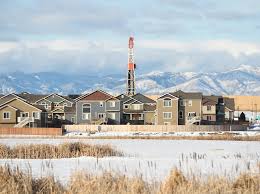
A new study by the University of Colorado finds those who live near oil and gas facilities might have a higher risk of getting cancer and other diseases. But one oil and gas group says the researchers have it wrong.
Researchers at the Colorado School of Public Health as well as NASA and the Boulder County Public Health department worked on the study. They concluded those people living near oil and gas sites in the Front Range are exposed routinely to dangerous levels of air pollutants and carcinogens.
Residents within 500 feet of a well had a lifetime cancer risk eight times higher than the maximum level accepted by the EPA.
“Our results suggest that Colorado’s current regulations that specify a 500-foot distance between a newly drilled oil and gas well and an existing home may not protect people from exposures to hazardous air pollutants that could impact their health,” said the study’s lead author Lisa McKenzie, PhD, MPH, of the Colorado School of Public Health. She added that thousands of Coloradans live closer than 500 feet from a well.
An estimated 356,000 people living in the northern Front Range are within one mile of an active oil and gas site, according to the report.
“The results underscore the importance of having policies that require effective monitoring and reducing emissions from oil and gas facilities, particularly those near homes, schools, and recreation areas,” said Pam Milmoe, Boulder County Public Health’s air quality program coordinator.
But the Colorado Petroleum Council took issue with the study and the report.
Tracee Bentley, executive director accused McKenzie of presenting the “public with activist research that seeks to generate soundbite headlines from unvalidated conclusions, outdated assumptions and/or flawed science.”
She said the study by McKenzie directly contradicts a recent Colorado Department of Public Health and Environment study that showed no need for public health action.
“Ms. McKenzie’s data is based on older data from 2014 and relies, in part, on old and limited data that the Environmental Protection Agency has not accepted.”





